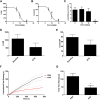Pharmacological Characterization of Orofacial Nociception in Female Rats Following Nitroglycerin Administration
- PMID: 33343340
- PMCID: PMC7744726
- DOI: 10.3389/fphar.2020.527495
Pharmacological Characterization of Orofacial Nociception in Female Rats Following Nitroglycerin Administration
Abstract
Rodent models of human disease can be valuable for understanding the mechanisms of a disease and for identifying novel therapies. However, it is critical that these models be vetted prior to committing resources to developing novel therapeutics. Failure to confirm the model can lead to significant losses in time and resources. One model used for migraine headache is to administer nitroglycerin to rodents. Nitroglycerin is known to produce migraine-like pain in humans and is presumed to do the same in rodents. It is not known, however, if the mechanism for nitroglycerin headaches involves the same pathological processes as migraine. In the absence of known mechanisms, it becomes imperative that the model not only translates into successful clinical trials but also successfully reverse translates by demonstrating efficacy of current therapeutics. In this study female rats were given nitroglycerin and nociception was evaluated in OPADs. Estrous was not monitored. Based on the ED50 of nitroglycerin a dose of 10 mg/kg was used for experiments. Sumatriptan, caffeine, buprenorphine and morphine were administered to evaluate the reverse translatability of the model. We found that nitroglycerin did not produce mechanical allodynia in the face of the rats, which is reported to be a consequence of migraine in humans. Nitroglycerin reduced the animals' participation in the assay. The reduced activity was verified using an assay to measure exploratory behavior. Furthermore, the effects of nitroglycerin were not reversed or prevented by agents that are effective acute therapies for migraine. Two interesting findings from this study, however, were that morphine and nitroglycerin interact to increase the rats' tolerance of mechanical stimuli on their faces, and they work in concert to slow down the central motor pattern generator for licking on the reward bottle. These interactions suggest that nitroglycerin generated nitric oxide and mu opioid receptors interact with the same neuronal circuits in an additive manner. The interaction of nitroglycerin and morphine on sensory and motor circuits deserves additional examination. In conclusion, based on the results of this study the use of nitroglycerin at these doses in naïve female rats is not recommended as a model for migraine headaches.
Keywords: female; migraine; nitroglycerin; operant assay; orofacial pain; rodent.
Copyright © 2020 Caudle, Caudle, Flenor and Neubert.
Conflict of interest statement
JN and RC are co-founders of Velocity Laboratories, LLC, which provided funding for this project. The remaining authors declare that the research was conducted in the absence of any commercial or financial relationships that could be construed as a potential conflict of interest.
Figures






References
-
- Anderson E. M., Del Valle-Pinero A. Y., Suckow S. K., Nolan T. A., Neubert J. K., Caudle R. M. (2012a). Morphine and MK-801 administration leads to alternative N-methyl-d-aspartate receptor 1 splicing and associated changes in reward seeking behavior and nociception on an operant orofacial assay. Neuroscience 214, 14–27. 10.1016/j.neuroscience.2012.04.032 - DOI - PMC - PubMed
-
- Anderson E. M., Reeves T., Kapernaros K., Neubert J. K., Caudle R. M. (2015). Phosphorylation of the N-methyl-d-aspartate receptor is increased in the nucleus accumbens during both acute and extended morphine withdrawal. J. Pharmacol. Exp. Therapeut. 355 (3), 496–505. 10.1124/jpet.115.227629 - DOI - PMC - PubMed
LinkOut - more resources
Full Text Sources
Research Materials

